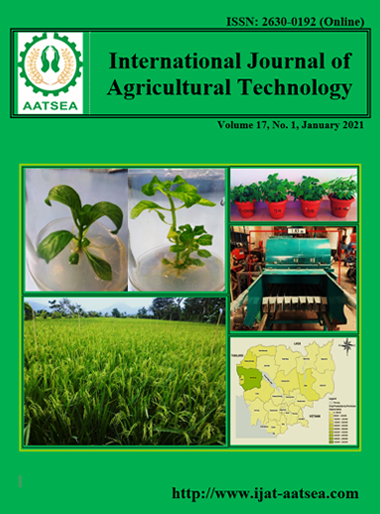Economic analysis of cassava production in Cambodia
Main Article Content
Abstract
The research indicated that the farmers had an average land holding over 7 hectares, with 58% of their land used for planted cassava. For the fresh root cassava, the yield ranged from 8.40 to 37.26 tonnes per hectare, with an average of 24.16 tonnes per hectare. The value-added and net profit represented 83.09% of the total production and 28.82% per hectare. The production cost was 1,058.19 USD per hectare and the break-even point was 43.79 USD per ton, with a return on investment of 1.40 USD. The dried chips cassava showing the value-added and net profit of the total production that accounted at 87.07%, and 33.21% per hectare, respectively. The dried cassava production, it involved a process of peeling and drying the fresh cassava, and the cost of that process was 19.56 USD per ton. The labour revealed mostly hired on cassava production which represented a cost of 21 to 25% of the revenue from the sale of their final products. Furthermore, the farmer's profit was reduced by 24% due to yield variation, although the price fluctuation was not a big issue. In addition, there was a high production cost, a poor investment in the processing of raw materials, and a dependence on the Thai export traders to the Chinese market. Therefore, it was undeniable that the price of cassava is a determinant factor that could represent a significant loss of added value in Cambodia
Article Details

This work is licensed under a Creative Commons Attribution-NonCommercial-NoDerivatives 4.0 International License.
References
Abassa, A., Amazab, P., Bachwenkizia, B., Wandac, K., Agonac, A. and Cromme, N. (2017). The impact of mechanized processing of cassava on farmers’ production efficiency in Uganda. Applied Economics Letters, 24:102-106.
AFSIS (2017). ASEAN Agricultural Commodity Outlook. Released by AFSIS Secretariat Office of Agricultural Economics (OAE). Ministry of Agriculture and Cooperatives, Bangkok, Thailand. http://www.aptfsis.org.
Appleton, S. and Balihuta, A. (1996). Education and Agricultural Productivity: Evidence from Uganda. Journal of International Development, 8:415-444.
CIAT (2018). Cassava: Facts and Fiction. Empowered lives-Resilient nations, Cambodia-UNDP. Retrieved December 14, 2018, from https://www.kh.undp.org/content/cambodia/en/ home/library/poverty/cassava-facts-and-fiction.
Ejike, R. D. and Osuji, E. E. (2013). The Role of Women in Sustainable Conservation Agriculture as a Viable Alternative to Traditional Farming Practices in Imo State, Nigeria. Proceedings of the 27th Annual Conference of Farm Management Association of Nigeria held at University of Ilorin, Kwara State, Nigeria, 26-30th August, 2013.
FAOSTAT (2017). FAOSTAT (database), Food and Agriculture Organization of the United Nations Statistics Division, Rome. Retrieved from http://www.fao.org/faostat/en/#home
Gasperini, L. (2000). Sustainable Development Department, Food and Agricultural Organization of the United Nations. Retrieved October 10, 2013, from http://www.fao.org/ sd/exdirect/exre0028.html.
Hing, V. and Thun, V. (2009). Agricultural Trade in the Greater Mekong Sub-region. The Case of Cassava and Rubber in Cambodia. CDRI Working Paper Series No.43
Hoa, A. X., Techato, K., Dong, L. K., Vuong, V. T. and Sopin, J. (2019). Applied ecology and environmental Research: Advancing smallholders’ sustainable livelihood through linkages among stakeholders in the cassava (Manihot esculenta Crantz) value chain: The case of Dak Lak Province, Vietnam, 17:5193-5217.
Luar, L., Pampolino, M., Ocampo, A., Valdez, A., Cordora, D. F. and Oberthür, T. (2018). Cassava Response to Fertilizer Application, Southeast Asia. Better Crops with Plant Food, 102:11-13.
IPNI (2012). 4R Plant Nutrition Manual. A Manual for Improving the Management of Plant Nutrition, (T.W. Bruulsema et al., eds.), IPNI, Peachtree Corners, GA, USA.
MAFF (2016-2017). Annual Report of Agriculture, Forestry and Fisheries 2016-2017 and Directions 2017-2018. MAFF Conference, April 2017.
MAFF (2015). Cassava Handbook. Phnom Penh, Cambodia. China-Cambodia-UNDP Trilateral Cooperation Cassava Project Phase II.
Martin, A., Jennifer, H., Daniel, K., Godrick, K., Celestin, K. N., Cyprien., N. N. and Wilson O. A. (2013). Cassava Farmer Field Schools. FAO Plant Production and Protection Paper 218.
Masamha, B., Thebe, V. and Uzokwe, V. N. (2018). Mapping cassava food value chains in Tanzania’s smallholder farming sector: The implications of intra-household gender dynamics. Journal of Rural Studies, 58:82-92.
Oduro-Ofori, E., Aboagye, A. P. and Acquaye N. A. E. (2014). Effects of Education on the Agricultural Productivity of Farmers in the Offinso Municipality. International Journal of Development Research, 4:1951-1960.
Olukosi and Jenny, O. (1999). Participatory Approach to Household Food Production and Security. Kaduna: International Development Seminar on Food Security, Social Mobilization and Community Empowerment.
Osuji, E. E., Maduike, I. A., Oguegbuchulam, M. N. and Eze, E. U. (2014). Effects of Farm Inputs on Productivity of Farmers in Imo State, Nigeria, International Journal of Applied Research and Technology, 3:3-9.
Ou, W., Li, M., Tin, M. A. and Sinath, S. (2016). Agriculture: Forestry and Fisheries: Current Situation of cassava Production, Constraints and Opportunities in Cambodia, 5:64-70.
Sewando, P. (2012). Urban markets-linked cassava value chain in Morogoro rural district, Tanzania. Journal of Sustainable Development in Africa, 14:283-300.
SNV Cambodia (2015). Cassava Value Chain Analysis Inclusive Business Model for Promoting Sustainable Smallholder Cassava Production (IBC).
Sopheak, T. (2017). Economic Analysis of Cassava Production in Cambodia. International Journal of Science and Research, 6:2403- 2406.
Sopheap, U., Makara, O., Howeler, R. H. and Aye, T. M. (2008). Enhancing cassava production and utilization through Nippon Foundation project in Cambodia, in: Howeler, R. H. (eds.), A New Future for Cassava in Asia: Its Use as Food and Fuel to Benefit the Poor. Proceeding of 8th Regional Cassava Workshop. 20-24 Oct. 2008, Vientiane, Lao PDR. CIAT, Cali, Colombia, pp. 460-469.
Yamane, T. (1967). Statistics: An Introductory Analysis, 1st Edition, New York: Harper and Row.
Yamane, T. (1973). Statistics: an introduction analysis, 2nd Edition, New York: Harper and Row.


